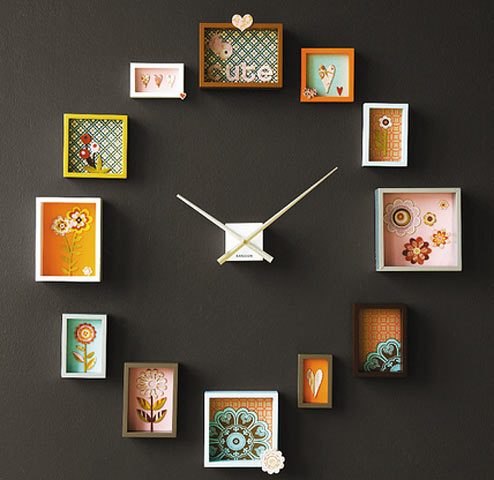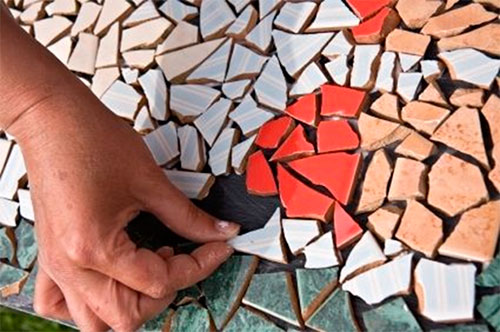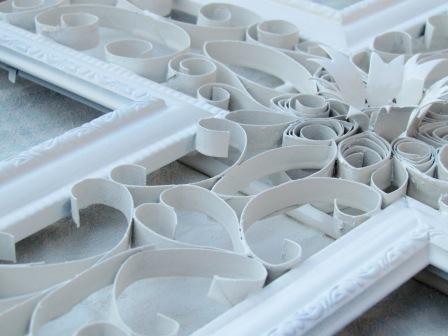Wanting to make the interior of their homes more piquant, many prefer not to buy expensive accessories, but simply to create an exclusive decorative panels, which are placed on the wall. This feature - the most interesting item of decor, which you can not only buy in the store, but also to make their own hands.
Content
Types of panels on the wall
For its size panels are very different - from the not very large to huge. At the same time, as a rule, it is used as a main accent or interior decoration.
Wall panels can be manufactured on the basis of the plywood, of cardboard, wood (chipboard, fibreboard), as well as fabrics, leather, plastic, glass and metal using various techniques - from inlays to embossing, by embroidery and knitting up the thread from decoupage before fusing, etc. This element can have plot, or represent a unique abstract image, interlacing geometric shapes and lines.
The material for its manufacture can be anything - fur, wire, old newspapers, photos, postcards, cutlery, dry leaves and branches, watches, pieces of mosaic, fragments of mirrors, buttons, yarn, etc.
Prettyly interesting and unusually look at the panel on the wall of the fabric, which is performed on the technique of Patchwork and pasted on the basis or tightly taut on the frame. Such a decor can be performed even a simpler method: cover the material with a wood panel using a fabric with Zhakord pattern or tapestry.
Today in stores you can find bulk and flat panels that are decorated with 3D applications, imitate the burner and bas-relief, as well as exclusive carvings. Volumetric "soft" wall panels are very aesthetically described, the pattern of which is created using small wall-mounted cloves having decorative hats.
In their form, beautiful panels on the wall can be curvilinear, in the form of a polygon, oval, round and square, as well as solid and consisting of several elements. Such an uncomplicated accessory will become the center of your interior, so it is necessary to approach his choice as much as possible.
Recommendations for the placement of the wall panel:
- for each room, it is necessary to select your own theme;
- if you purchased a mirror panel on the wall, then it is so that the daily or artificial light falls directly to it - due to this, visual harmony and balance will be created;
- wall panel will look good if there is free space around it;
- it is not recommended to hang a frame with photos or pictures next to it;
- the optimal distance from the floor to the composition is 1.7 m.
How to make a panel on the wall
Panel on the wall of the fabric
Panel on the wall with their own hands, created from the fabric - an interesting and sufficient simple solution. This element of the decor can be performed, even without having special skills, harmoniously combining it with wall decoration or other textiles.
In order to make a tissue decorative panel, you can use the old frame from the window, mirrors or paintings, as well as make it yourself from a thin sheet of chipboard or dense cardboard.
The first method:
- initially, the selected material should be tightened.
- then it is necessary to wrap it on the opposite direction and secure glue that is used for internal work;
- next, the finished base is attached to the frame.
The second method:
- a frame of wooden plates is prepared;
- cut with a bunch of a piece of fabric;
- the material is tensioned on the frame and is attached on the back of the nails, glue or stapler.
Third method (without framework):
- a piece of plywood is taken;
- sinypron or foambone is glued on the front side;
- the plywood is then covered with the material that is fixed on the back side of the stapler.
Panel from tile on the wall
Today, the most fashionable technique is a mosaic from mirror pieces. Using this method, you can make not only the decorative panel, but also a frame for a photo, a vase or fragments of walls.
Progress:
- tile fragments, the pieces of the old mirror and the ceiling should be cut about the same size using glass cutter;
- then the surface on which the sticking will be produced is cleaned from dust and dirt;
- next, "liquid nails" are applied to the dry basis and each fragment of the basic background color is glued;
- between fragments, it is necessary to leave a gap of 2.5-5 mm;
- mosaic is glued with an ornament or a predetermined drawing;
- the composition can be diluted with shells, stones, beads and glass;
- after the standing is finished, we divorce the grout and apply it to the rubber spatula;
- with a damp sponge, we remove the surplus surplus and let it dry for 2-5 hours.
Punk on the wall of photos
Make a wall panel from photos is quite simple. To do this, buy in any store a large frame with glass and fill it with fragments of your life. However, it is possible to arrange a unique thing yet using quilling technique, which allows you to create an openwork decor and practically does not require expenses.
We will need:
- white paint in the balloon;
- scissors;
- cardboard;
- pVA glue;
- 5 deek from wood;
- 4 frames for photos.
Progress:
- with the help of wooden rails, a frame is created on which the frames are glued;
- then there is a pattern from the twisted paper strips for quilling techniques between the frames;
- after the design is completed, the whole design is painted paint from the can.
Wooden panel on the wall
We will need:
- electrolovik;
- sandpaper;
- "liquid Nails";
- morid;
- the same in thickness, but different widths of wooden boards;
- plywood leaf.
Progress:
- boards are rapid at an angle of 45 ° at the required length;
- then they should be schematically distributed on the plywood sheet;
- before sticking the board, you need to handle the sandpaper, cover the veneer and give it to dry;
- to create aged species, process the edges of the sandpaper;
- the finished product is varnished;
- after the board dry, glue them to the plywood.
To place the edge of the wall panels, cut lengths of boards of desired length, cover them with paint or stain and fix the ends of the structure. The gaps between the frame and the boards can decorate wood putty.
Mirror panels on the wall
The manufacturing process involves a series of steps:
- draw a sketch with putting all the size parameters;
- further from a cut sheet of mirror elements which are numbered;
- edge parts are processed and posted in the correct order on a sheet of plywood;
- glue composition is best to "liquid nails".
Mirror panels can be diluted with pieces of mosaic tiles, which is placed in a diamond or rectangle.
The basic rules of installation mirroring panels:
- for fixing the mirror panels, use a perfectly smooth surface, otherwise the image it will break down and become distorted;
- make sure that the lateral edge of the panel did not coincide with the boundaries of the outer corners, provide curb or baguette;
- limit lines can be absolutely any - horizontal, straight, circular, vertical and inclined.
Mural on a wall of bamboo
When creating a bamboo panels, which will sink into the wall, stick to certain requirements:
- place the composition away from heaters;
- maintain a certain indoor humidity;
- do in each vertebra stem hole diameter of 2 mm to plant ventilated inside;
- bamboo cover several layers of lacquer.
To make a bamboo decorative panels, it is enough to stick on the plant in a vertical wall, horizontally or diagonally. Thus, we can draw the headboard in the bedroom, put a miniature conservatory in the living room or the space available in the TV. In addition, the stem of the plant can be zoned space, forming partitions, bar counters and decorative columns.
Panels on the wall with his hands video:





































Photo tiles Panorama Dekol.Keramicheskaya photo tiles - it is easy to transform the interior?
Transform the kitchen or bathroom interior will help the original panel from the photo shot. Unlike the classic, any image can be applied to it. What exactly - to solve you. You can choose the image from our directory, and you can send your own.
Creation of photo copy
There are several ways to create a photo filter:
• UV printing;
• sublimation;
• hot decal;
• Cold decol.
We advise your customers to choose a photograph made with hot decolition. This manufacturing method is one of the highest quality and durable, as in the process of applying an image to the tile, it is protected by a special layer of glaze.
In the process of hot decolition, the image is applied to ceramics at 860 degrees. With such a high temperature, the icing becomes very soft and the paint easily penetrates the tile. After the drawing was transferred to the tile, it will remain waiting for a complete cooling.
Such a tile has a warranty of 30 years, while manufactured by any other way, has a guarantee for only 2 years.
Application area
If you make repairs in the kitchen or in the bathroom, you are most likely to use ceramic tiles as a finishing material. So that the room looks stylish - it is important to supplement it with some bright items. Such a part can be panel from the photo shield. The size of the panel you claim yourself, because the tile is easy to cut, and it is easier to create a panel of any size easier.
Panel from the photo shot perfectly fit into the kitchen apron or in the bathroom - you can choose a suitable image and place it along the entire length or width. Such a design solution will significantly transform the interior, will add comfort and grace.
Why poverty is a disease
http://nautil.us/issue/47/conscious/why-poverty-is-like-a-disease.
Gick health,
Finance,
Biotechnology
Translation
image.
According to the description of my achievements today, you would never have guessed that I grew up in poverty and hunger.
My last salary for the year has passed for $ 700,000. I am a member of the National Security Society for the Truman National Security [is engaged in the search and promotion of the future leaders of the American Nation - approx. Transl.] and member of the Council on International Relations. My publisher recently released my last series of books on the quantitative distribution of global finances.
And all this is not enough for me. I constantly feel myself in a state of "Bay or Run", waiting for a trick, or the onset of hungry days. I even decided not to make children, because, despite all the successes, I do not feel a safe financial pillow. The minimum status of the account, in which I am willing to think about children is a very big figure. If you were familiar with me personally, you could catch signs of stress, insecurity, anxiety and depression. And hear about Tennessee.
No resident of Tennessee tells you that he is just from Tennes. He will definitely add: East, Western or average. My life began in Eastern Tennessee, in the town of Rokwood, Apalace region. I was the oldest of four children in the family, whose income did not allow and one. Each Pentecostal Church of this heroin outfice smelled equally: a heavy mixture of cheap detergent and even cheaper lodge, with a small admixture of forgotten hope. One of these abandoned churches was, in essence, my orphanage and school.
image.
The educational class was one room in which 20 people, age from kindergarten before the 12th grade, were engaged in the "Accelerated Christian Training" technique. We were distributed to the booklets that we had to read on their own. We ourselves made themselves for homework. There were no lectures, and I did not have a teacher. Sometimes the wife of the preacher distributed tests. We were not allowed to do anything. There were no films, no music. You could pass years, during which nothing happened, which would distinguish one year from the other. There was no speech and any social events.
I spent all my time, reflecting on simple questions. Where does my next lunch come from? Will I have electricity tomorrow? I watched my mother tries from shame to hide coupons on food at the facility of the grocery store. I remember how for eight years I have experienced a panic because of the constant uncertainty about absolutely all aspects of life, from food to clothing and learning. I knew my life could not be normal. Something was wrong with the tiny microcosm, in which I was born. I just did not know what it was.
I thought, I thought I realized that there was not there. I always believed that my upbringing made me cautious and prudent. But over the past few decades it turned out a lot of new things. We learned that stress connected with poverty can change your biology as we have not represented earlier. It can reduce the surface of the brain, shorten the telomeres and life expectancy, increase the chances of obesity and a tendency to excessive risk.
And now there are information about the fact that these changes can be even deeper - up to the level on which our bodies collect themselves, changing the types of cells from which they are made, perhaps even before the expression of genes with which the body is played, As with a rubble cube, abandoned in a washing machine. If the research results receive confirmation, it will mean that poverty is not just a socio-economic condition. It will have a set of related symptoms that can be prevented and treated, and even inherit. In other words, the results of poverty begin to resemble very much on the symptoms of the disease.
The word "disease" carries a negative shade. I do not mean that poor people are some bad or spoiled. I mean, poor people are sick, and everyone else tells them that their condition is the necessary, temporary and even positive part of modern capitalism. We are talking to the poor that they have a chance to break out, just hardly working hard; That we are all equally involved in the system, distributing equally awards and punishment. We point out the rare stories of "the poor in rich," as it happened to me, and all this fit into the template of meritocracy [letters. - "Power worthy," - approx. Transl.]
But my advantages are not related to how I escaped from there.
We may not remember 1834 as a record, but it was such in the field of organic chemistry. It was then that Jean Batiste Dumas and Eugene Peligo distilled from heated sawdust and analyzed the transparent liquid, which they called methylene, and we call methanol, wood alcohol. It is based on a methyl group consisting of one carbon atom associated with three hydrogen atoms. And as it turned out 150 years later, methyl groups play a crucial role in the expression of genes.
In the fall of 1991, Aaron Razin and Howard Cedar published the unusual work "Methylization of DNA and the expression of genes", which showed that the work of the expression of genes very much resembles a snake, tightly rolled around aclepium. [Razin, A. & Cedar, H. DNA Methylation and Gene Expression. Microbiological Reviews 55, 451-458 (1991)] On strong interlacing of our genetic code are methyl groups controlling how tight our genetic code is wrapped around special proteins called Histons. The tightly part of the code is twisted, the less likelihood of its influence on anything, that is, the less likely to "expression". This is one of the pillars of Epigenoma: Your human appearance is defined not only to DNA, but also by how it parts of your epigent allows expression.
Six years later, Michael Mini, a professor at the University of McGell, specializing in stress biology, together with colleagues published a revolutionary result: the quality of maternal care affects the epigent of rats, on glucocorticoid stress receptors in the hippocampus, as well as on the hypothalamic-hypophized and adrenal axis reaction (HPA ) on stress. [Liu, D., et al. Maternal Care, Hippocampal Glucocorticoid Receptors, and Hypothalamic-Pituitary-Adrenal Responses to Stress. Science 277, 1659-1662 (1997)] Similar effects were later discovered from Zebra Amadin, which, like people, socially monogamans, and whose children are growing both parents. The levels of information RNA glucocorticoid and mineralocorticoid receptors in birds devoid of mothers were lowered, in connection with which adult birds stress hormones remained elevated much longer. Researchers wrote that epigenetic mechanisms may be responsible for these changes - but they did not prove it. [Banerjee, S.B., ARTERBERY, A.S., Fergus, D.J., & Adkins-Regan, E. Deprivation of Maternal Care Has Long-Lasting Consequences for the hypothalamic-Pituitary-Adrenal Axis of Zebra Finches. Proceedings of the Royal Society B 279, 759-766 (2012)]
image.
Human children have epigenetic changes in the expression of stress receptor genes, leading to a strengthened reaction to stress and mood problems, researchers are associated with severe childcare. [McGowan, P.O., et al. Epigenetic Regulation of the Glucocorticoid Receptor in Human Brain Associates with Childhood Abuse. Nature Neuroscience 12, 342-348 (2009)] And last year, researchers from the University of Duke found that "low socioeconomic status during matters is associated with an increase in the methylation of the nearest Promotor of the serotonin conveyor," leading the almond-shaped body to the predisposition to the "reactivity associated with Threat. " [Swartz, J.R., Hariri, A.R., & Williamson, D.E. An Epigenetic Mechanism Links SocioEConomic Status to Changes in Depression-Related Brain Function in High-Risk Adolescents. Molecular Psychiatry 22, 209-214 (2017)] And although the predisposition to high stress levels has its advantages (for example, training in a state of stress can accelerate [Champagne, DL, et al. Maternal Care and Hippocampal Plasticity: Evidence for Experience-Dependent Structural Plasticity, Altered Synaptic Functioning, and Differential Responsiveness to Glucocorticoids and Stress. Journal of Neuroscience 28, 6037-6045 (2008)]), the basic essence of these studies is such: chronic stress and insecurity in childhood leads to the fact that in adulthood Stress to cope more difficult.
On the one hand, epigenetics offers an intriguing statement of our life, going to reversing up to the main "program" making you who are you. But in this area there are fundamental contradictions. Last year, a team of researchers from Albert Einstein's medical college in the University of Bristol and the European Institute of Bioinformatics published a work described how this area is contaminated by the incorrect interpretation of research results. For example, often researchers cause with a consequence (diseases can lead to the emergence of epigenetic markers, and vice versa); Fake or incorrectly interpret statistics; Mixing variables leads to a visible correlation of parameters; Not taken into account the great change of epigenome from the cell to the cell.
John Grily, one of the co-authors of the study, believes that some notable results in this area, including those that received mini suffer from the indicated problems. "During research mini it was believed that if I observe a change in DNA methylation in rats, which did not lick mom, or in cells of children from the lowest socio-economic group, or someone else, then I learn how people are reprogrammed under the influence of environmental conditions. But the change in DNA methylation explains not only that cells were reprogrammed or not. They are also associated with the proportions of cell subtypes, each of which has its epigers available from compared organisms. Grill with co-authors call it methaepigen.
But Grill notes that even if this molecular mechanism does not reprogram the cells through methylation, and the cell subtype shift - there is still something to reflect. "Even if you find a change in proportions, admit, cell subtypes in peripheral blood, which is associated with such things as low socio-economic status, it will be a very interesting discovery," he says. "Then we will return to the question of determining what epigenetics is." It is possible that the shift in the subtypes of the cells inherit, although this does not include the reprogramming of cells through methylation. Tim Spector from the Royal College in London, for example, discovered the variants of DNA sequences associated with variations of cell subtypes.
Studying the biological effect of stresses associated with poverty is still in early stages. At the same time, she already gave us many mechanisms capable of providing such effects, many of which contain the inherited component. If, for example, a pregnant woman is subject to stress poverty, its fruit and fetal gamets can suffer from this, as a result of which these effects apply to at least its grandchildren. Or maybe further.
image.
Studies of mice and drosophyl showed that the epigenetic features similar to those that mentioned mini can be inherited and maintained at least in dozens of generations. The consequences of such things as diet and predatory stress are inherited not only through the modification of histones, but also through the methylation of DNA and the non-coding RNA [LIM, J.P. & Brunet, A. Bridging The Transgenerational Gap with Epigenetic Memory. Trends in Genetics 29, 176-186 (2013)]. In the study from 2014, siblings of the mouse, trained to fear of a certain smell, were also afraid of this smell, although they did not feel it before. This effect was maintained for two generations [DIAS, B.G. & Rassler, k.j. Prenatal Olfactory Experience Influences Behavior and Neural Structure in Subsequent Generations. Nature Neuroscience 17, 89-96 (2014)]. People inherited consequences of stress have been observed at least in three-generations in people whose ancestors suffered from mass hunger (hungry winter of 1944 in the Netherlands [Heijmans, BT, et al. Persistent Epigenetic Differences Associated with PRENATAL EXPOSURE TO FAMINE IN HUMANS. Proceedings of The National Academy of Sciences 105, 17046-17049 (2008)]), food interruptions (Everkalic experiment [Pembrey, M., Saffery, R., Bygren, Lo, & Network in Epigenetic Epidemiology. Human Transgenerational Responses to Early-Life Experience: Potential Impact On Development, Health and Biomedical Research. Journal of Medical Genetics 51, 563-572 (2014)]) and at the Holocaust. The consequences of smoking or tobacco chewing by parents in young age can be transmitted to their children depending on the floor, which proves the presence of epigenetic effects in people [pembrey, M.E., Bygren, L.O., & Golding, J. The Nature of Human Transgenerational Responses. In Jirtle, R.L. & Tyson, F.L. (EDS.) Environmental Epigenetics in Health and Disease Springer Publishing, New York, NY (2013)]. According to the observations from 2014, "several studies of people indicate the existence of epigenetic effects on the male line, which cannot be explained by cultural or genetic inheritance."
Even at the current stage, we can extract some information from science. First, stresses associated with poverty have biological consequences lasting all their lives. Secondly, there is evidence that these consequences can be inherited or through the impact on the fetus, either through epigenetics, through cell subtypes or somehow else.
And these scientific data make us reconsider the cornerstone of American mythology and our policies aimed at the poor: the ability to break through the possibility without any help. Stories about people who have made themselves who spent themselves from their surroundings due to the stubborn and hard work. The support platform of meritocracy, where the awards allegedly come to those who most deserve them.
What kind of independent exit from the environment or fair distribution can be said if poverty injured participants of the "competitions"? Especially if it is also transmitted through generations? And the ugly consequence of the hypothesis of "independent exit", saying that people who did not choose from heavy circumstances deserve them, has even less sense in the light of the gloomy biology of poverty. When the starting gun sounds, the poor are far behind the starting line. I was so accurately there, despite my current success.
So how did I get out from there? By chance.
It would be very easy for my story, explaining all the talents and stubborn work, because it is precisely all of us that everything is fed, from Hollywood to political figures. But it would be wrong. My flight occurred thanks to the sequence of surprisingly unlikely events, none of which was not subject to me.
By 14 years, I have already tried to selfishly at least for 8 years with photocopyed booklets, without textbooks, lesson plans, help or at least a teacher. I desperately tried to get out and was terribly afraid to become the same as people around me were. So I took the phone book and began to call the professional, colleges, all and everyone who could give me opportunities. Randomly and unexpectedly, I came to the president of the Community College [A two-year college, which preparing secondary qualifications specialists to work in the local community - approx. Transl.] Sherry Hoops. When I first met her, I was probably 12 years old, and even at that age I could understand that my story was not unique for her.
In the same college, I met Bruce Centrell, a professor who replaced my father when I was 15, and I was poor. He also grew up in poverty, but as a result he was gone into people. We especially did not talk about our experience, but somehow they immediately found a common language. A few years later, he went into politics and made me the manager of his election campaign. We won, and I received an invaluable education in the real and unceremonious politician of the district of Roan. I will be forever grateful to Bruce and Sherry. With their help, I finally got a college degree.
Did I show the initiative? Of course. Many interpreted my poverty escape as a confirmation of the existence of meritocracy justifying the entire system. But the outback is filled with people, as desperately trying to get out of there, like me, and taking the same inventive measures. So I am an exception that confirms the rule is a rule that escape from poverty is possible only by chance, and not because of some virtues.
I have relatives and friends as far as smart and hardworking, like me, and about the same, or with the best, education. But none of them got out of poverty. One of them also got into the community college, but only after he witnessed how his best friend committed suicide under the influence of drugs. It turned out to be a one-way ticket to life filled with emotional problems. The other was lucky to get into the accredited free secondary school, where they give much more knowledge than in the course of "accelerated Christian education." He became a heroin addict. For them, the path to education did not, as for me, wonderfully free from obstacles. They did not become like me, the head of the company selling derivatives on Wall Street. They do not write like me, about poverty. They live in her. And for today I can count about 20 relatives and friends who spread goodbye to life through weapons or heroin. I have no doubt that this year their number will increase.
image.
Why so little people escape from poverty? I can testify by experience - not because one is more advantageous than others. This is due to the fact that being the poor thing means to risk a major risk. The asymmetry of the results for the poor is so huge, since being poor is very expensive. Imagine that you lost work because your phone did not work, or you did not pass the exam, because you spent the whole day in resuscitation because of the ailment, which would be eliminated by timely treatment. Such simple misfortunes can run the whirlpool of failures from which it will not be possible to get out. The reality is that if you are poor, and made only one error - you have an end. Life turns into a gambling with death in the form of a loss.
Now imagine that your brain is arranged so as to multiply a subjective feeling of stress by 10. As a result, you focus on short-term plans. By those who were lucky to not familiarize themselves with the calculus of the poor, it seems that the poor once receive non-optimal solutions. But the choice of poor people in their circumstances is very intelligent. It is impossible to argue about the optimal solutions designed for a long period if you have two days left. Stress acquires a completely new meaning, and it is very difficult to get rid of it.
The standard American myth about meritocracy incorrectly assesses such stories as mine. The accumulated social capital of American institutions is a stable transfer of power, the power of the law, entrepreneurship - of course, creates economic miracles every day. But these institutions are primarily suitable for exponential growth in capital where it is already there, and not to create a new capital where it needs to society. My stories like mine are considered archetypes, and we are all unreasonably believe that the way to achieve runoff speed exists for entire population segments. But I here represent the success story on the type "from the dirt in the prince", and I declare that this story is a myth. The term "meritocracy" was invented in 1958 to mock the very idea of \u200b\u200breceiving awards for advantage. We forgot what you need to laugh, and the joke turned against us.
It is time for us differently to poverty and take into account new scientific data describing it.
Take education. One of the most active relationship researchers between poverty and achievements in study, as well as subsequent economic problems, is Roland Freier from Harvard. Together with the colleagues, he in the work "For this, it may not be necessary to help the entire village: increasing the achievements of the poor" [Allusion to the saying "to bring up a child to the whole village", meaning that the child brings up all the local community - approx. Transl.] Focused on reducing the difference in achievements between rich and poor, using various school learning strategies.
But the standard indicator of the difference of achievements - progress in mathematics is a symptom, not the reason. When supporting social programs for schoolchildren stops, their positive effect comes on no, and we begin to skeptically refer to the destruction of poverty. But academic successes are not the main problem. The problem is in uncertainty and stress. When the national assessment of educational progress in 2011 did not find any city in America, where more than at least 25% of eight-graders from black or Latin American families would have owned mathematics and reading at the level of their class, we must accuse the schools, or conclude What did we lose in the neurobiological race before tested these children?
image.
We must use the knowledge gained by the science about poverty, and not ignore them. Poverty elimination programs, such as conditional cash benefits, are awarded parents or guardians for specific actions, for example, for tracking school attendance or health prevention. They encourage the elimination of stress and long-term planning, and it goes far beyond the framework of simple exams - they provide exactly the sense of confidence that is necessary to be affected by the brain. In 2009, Lia Fernald and Megan Ganer showed that such programs reduced cortisol levels in saliva and the risk of mental and physical illnesses during life [Fernald, L.C.H. & Gunnar, M.r. Poverty-Alleviation Program Participation and Salivary Cortisol in Very Low-Income Children. Social Science & Medicine 68, 2180-2189 (2009)]. Such programs should be more. For example, the so-called long-term care programs for the child: they are engaged in the development of children from birth and the first three years of its growth [in the US Federal Law gives the right mother to take a unpaid decree leave for 12 weeks, starting not earlier than 2 weeks before the expected date Births provided that the future mother worked in the company for more than a year - approx. Transl.]
Our new scientific understanding of the influence of poverty can change the medical care of adults. In 2009, Michael Mini, Gustavo Turkish, Moyshe Zif and their colleagues were taken by Hippocampus samples in victims who have experienced violence, and tested DNA methylation, managing the expression of the NR3C1 gene. They found increased methylation in the Promoteiter NR3C1, which other studies directly connected with a decrease in protein expression called a neurotrophic brain factor (BDNF). BDNF refers to the most active neurotrophic factors, governing the growth and development of new neurons even in adulthood. And the expression level can be inherited. In 2015, a link between NR3C1 was discovered between the NR3C1 and a decrease in the expression of BDNF in babies whose mother noted the presence of presence of prepar depression [Braithwaite, E.c., Kundakovic, M., Ramchandani, P.G., Murphy, S.E., & Champagne, F.A. Maternal Prenatal Depressive Symptoms Predict Infant NR3C1 1 F and BDNF IV DNA Methylation. Epigenetics 10, 408-417 (2015)].
It may be that BDNF is your best friend if you are an adult and want to change your neurobiology. It can open the way to change the structure of the brain in those areas that suffered the strongest of early stress and poverty: prefrontal crust, hippocampus, and the entire hypothalamic-pituitary-adrenal axis. And these parts of the brain manage long-term memory, emotions and postponed awards. All these are signs of people, better cope with study in adolescence and more reaching in maturity [XU, X., et al. A Significant Association Between BDNF Promoter Methylation And The Risk of Drug Addiction. Gene 584, 54-59 (2016)] [Kheiroori, S., Norazar, S.G., Alizadeh, M., & Dana-Alamdari, L. Elevated Brain-Derived Neurotrophic Factor Correlates Negatively With Severity and Duration of Major Depressive Episodes. Cognitive and Behavioral Neurology 29, 24-31 (2016)]. Small doses of ketamine have an impact similar to rapid antidepressants, and this is directly related to increasing BDNF levels [Haile, C.N., et al. Plasma Brain Derived Neurotrophic Factor (BDNF) and Response to Ketamine in Treatment-Resistant Depression. International Journal Of Neuropsychopharmacology 17, 331-336 (2014)].
I would have tried such treatment myself. But my main interest in the study of poverty is in another place. It stems out of concern about the future.
We are on the edge of the cliff and we need to urgently revise our understanding of poverty and inequality. Western Neo-Liberals tell us a fairy tale that if you work hard, everything is formed. And if nothing is formed, they blame the victim in everything, and do not leave him a choice. Bracisite, Le Pen and the defeat Hillary Clinton are examples of problems originating from inequality and poverty. Petti's forks are already unchanged [French economist who wrote a popular book about economic inequality in Europe and the USA - approx. Transl.], And the Marsh of Global Disorder can be stopped, only applying measures opposing the corpus deck, which everyone born in poverty, including me.
I am confident that the Italian Party "Movement of the Five Stars" this year will launch a referendum on the exit from the EU, and that Marin Le Pen has every chance to win the French elections [did not win, but is going to participate in parliamentary elections - approx. Transl.] The EU can take the blame for the defeat of globalists and fall apart after two years.
Such trends are accelerated by believe in which the poor could not grasp the possibilities created by the globalized market. This myth is time to strange - and emerging empirical scientific studies of poverty can help us in this if we will have a deserved attention to them.